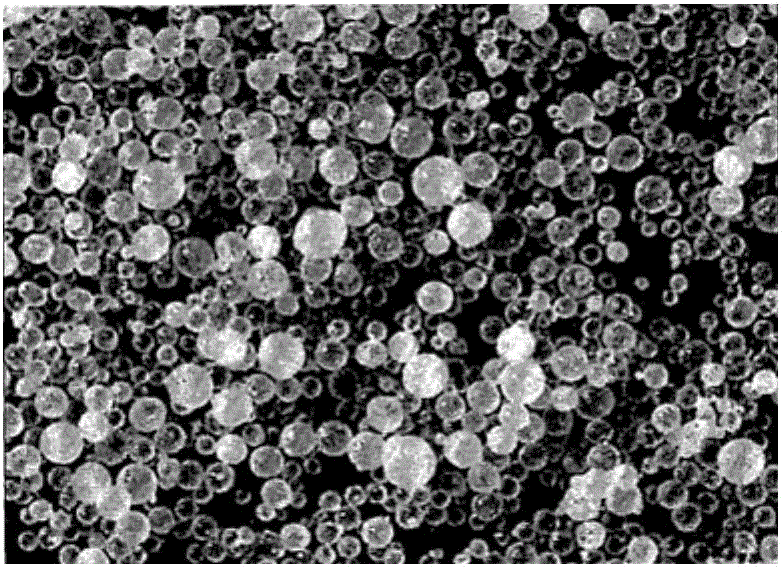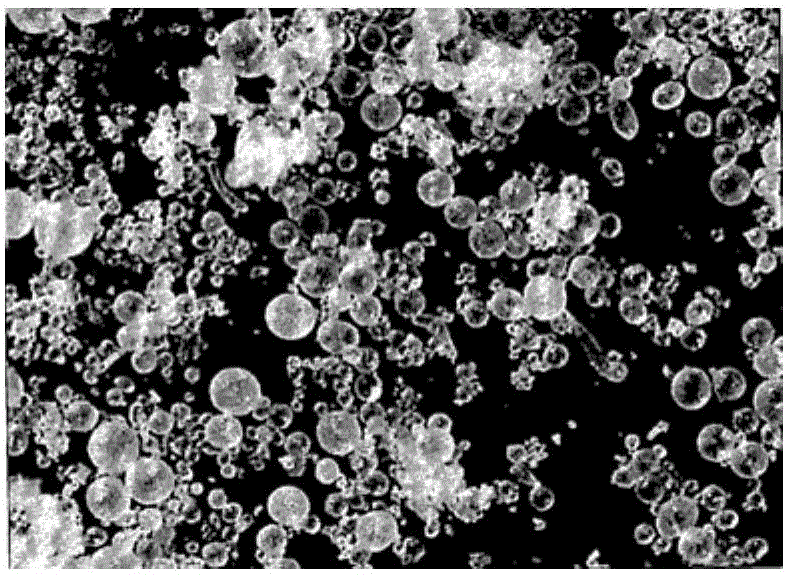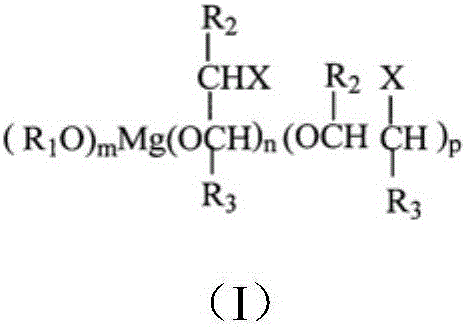Olefin polymerization method
A technology of olefin polymerization and compounds, applied in the field of olefin polymerization, can solve the problems of complex reaction by-products, carrier adhesion, low polymer bulk density, etc., and achieve good particle shape effect
- Summary
- Abstract
- Description
- Claims
- Application Information
AI Technical Summary
Problems solved by technology
Method used
Image
Examples
Embodiment 1
[0045] (1) Preparation of carrier
[0046] In a 500ml reaction kettle, add 150ml of white oil, 30g of magnesium chloride, 50ml of absolute ethanol, 2.0g of diethoxymagnesium and 0.012g of sodium chloride, and raise the temperature to 125°C while stirring. After constant temperature reaction for 2 hours, a liquid mixture was obtained.
[0047] Press the liquid mixture into 300ml of methyl silicone oil preheated to 125°C, and stir at high speed (1600rpm) to disperse and emulsify for 30min.
[0048] Introduce the emulsified product into 2L hexane solution pre-cooled to -35°C, and after rapid cooling, disperse into small droplets of MgCl 2 After the alcoholate melt is cooled and solidified, it becomes spherical particles. The liquid was removed by filtration, the solid was washed 5 times with 300 ml of hexane, and vacuum-dried at 30° C. for 1 hour to obtain a solid carrier of magnesium chloride alcoholate.
[0049] by infrared spectroscopy and 1 After HNMR nuclear magnetic mea...
Embodiment 2
[0059] (1) Preparation of carrier
[0060] In a 500ml reaction kettle, add 150ml of white oil, 30g of magnesium chloride, 50ml of absolute ethanol, 4.0g of diethoxymagnesium and 0.012g of sodium chloride, and raise the temperature to 125°C while stirring. After constant temperature reaction for 2 hours, a liquid mixture was obtained.
[0061] Press the liquid mixture into 300ml of methyl silicone oil preheated to 125°C, and stir at high speed (1600rpm) to disperse and emulsify for 30min.
[0062] Introduce the emulsified product into 2L hexane solution pre-cooled to -35°C, and after rapid cooling, disperse into small droplets of MgCl 2 After the alcoholate melt is cooled and solidified, it becomes spherical particles. The liquid was removed by filtration, the solid was washed 5 times with 300 ml of hexane, and vacuum-dried at 30° C. for 1 hour to obtain a solid carrier of magnesium chloride alcoholate.
[0063] by infrared spectroscopy and 1 After HNMR nuclear magnetic mea...
Embodiment 3
[0068] (1) Preparation of carrier
[0069] In a 500ml reaction kettle, add 150ml of white oil, 30g of magnesium chloride, 50ml of absolute ethanol, 2.0g of diethoxymagnesium and 0.015g of manganese chloride, and raise the temperature to 125°C while stirring. After constant temperature reaction for 2 hours, a liquid mixture was obtained.
[0070] Press the liquid mixture into 300ml of methyl silicone oil preheated to 125°C, and stir at high speed (1600rpm) to disperse and emulsify for 30min.
[0071] Introduce the emulsified product into 2L hexane solution pre-cooled to -35°C, and after rapid cooling, disperse into small droplets of MgCl 2 After the alcoholate melt is cooled and solidified, it becomes spherical particles. The liquid was removed by filtration, the solid was washed 5 times with 300 ml of hexane, and vacuum-dried at 30° C. for 1 hour to obtain a solid carrier of magnesium chloride alcoholate.
[0072] (two) preparation is used for the catalyst of olefin polymer...
PUM
 Login to View More
Login to View More Abstract
Description
Claims
Application Information
 Login to View More
Login to View More - R&D
- Intellectual Property
- Life Sciences
- Materials
- Tech Scout
- Unparalleled Data Quality
- Higher Quality Content
- 60% Fewer Hallucinations
Browse by: Latest US Patents, China's latest patents, Technical Efficacy Thesaurus, Application Domain, Technology Topic, Popular Technical Reports.
© 2025 PatSnap. All rights reserved.Legal|Privacy policy|Modern Slavery Act Transparency Statement|Sitemap|About US| Contact US: help@patsnap.com



